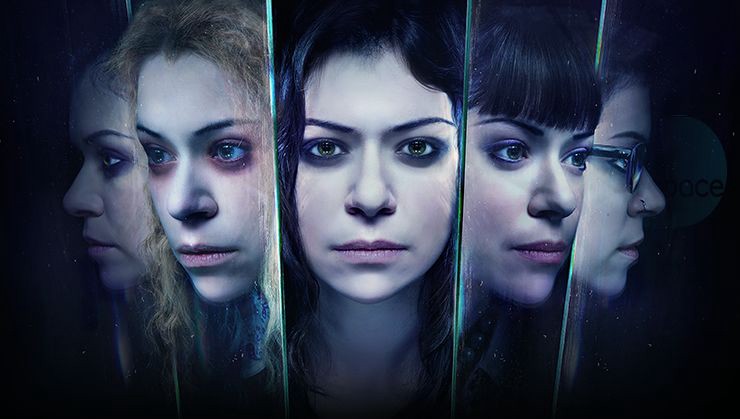“Orphan Black,” the BBC’s endlessly twisty clone thriller, kicks off its new season tonight (if your memory’s hazy, you can get up to speed here). Thankfully, the show seems to have found a way to stop, or at least temper, the plot scope creep that had set in by the end of last season.
Tatiana Maslany’s ridiculously versatile performance always kept me coming back for more, but it was frustrating that every discovery the Clone Club made was met by someone saying, “It goes way deeper than that;” that there was always another, bigger secret; always someone who wasn’t telling the whole story; always an opportunity for Sarah to go rogue and chase down someone she shouldn’t; every episode a new and startling revelation, which paradoxically can just get exhausting, especially when you’re talking genetics. I have limited patience for this kind of storytelling (I blame you, “Lost”), even with a show whose central premise — that these women, created as a science experiment and unknowingly paired with mostly-male “monitors,” have broken free to make their own future — is one of my all time favorite sci-fi plots.
Season 3 ended with some compelling loose ends — the most urgent of which is, who shot Delphine? — but I’m happy the show is exploring a different avenue at the start of the new season: Namely, what exactly happened to Beth Childs? She, as you will remember, is the clone who started it all, when grifter Sarah Manning saw her doppelganger throw herself in front of a train in the show’s first episode.
In a sort of half-prequel, the show flashes back to Beth’s life as a cop, her Skype sessions with Alison and Cosima and her connection to another clone we haven’t seen before: M.K., who has a slightly unplaceable accent and a whole lot of paranoia. The portrayal of Beth’s last days is a sad affair; she’s drug-addicted and possibly sick, and deeply distrusting of Paul (Dylan Bruce), whom M.K. has warned her is a spy.
As soon as you jump back into the world of “Orphan Black,” you remember why Maslany deserves all the awards even though she rarely ever gets them. I find it nearly impossible to watch a few minutes of this show and remember that all the female clones are played by the same person. This sounds like exaggeration, but it’s really not: She’s that good. And as much as I admire the tricky stunt scenes where they get all the Maslanys in one room together, it’s almost more impressive to watch all her various characters off on their own adventures.
We toggle between Beth in the past, and the present where Sarah, Mrs. S. (Maria Doyle Kennedy), her chimera mom Kendall Malone (Alison Steadman) and Sarah’s daughter Kira (Skyler Wexler) are holed up in Iceland (I think? The crooning of Sigur Ros at the end of last season would suggest so). No rest for the weary, for this crew; the bad guys are onto them.
Season 4 seems to have rediscovered a bit more of the fun side of “Orphan Black.” One welcome return: Naked painting Felix (Jordan Gavaris)! Having skipped the trip to the hinterlands, he’s once again making art in just an apron in his (weirdly giant; are the rents in Toronto that good?) loft space. Felix has spent so much time being a good soldier for the clones, it’s nice to see him allowed to have his own life again, if only momentarily.
I think bringing the Neolutionists back to center stage is a good move, too. With their freaky body-mod clubs and half-baked genetic-self-determination philosophy, this group makes a much more entertaining foe than the sterile suits of the Dyad Institute. And the discovery that Beth makes about one of their latest endeavors — remember that worm that came out of the dying Dr. Nealon’s mouth as he loomed over Delphine? — and its fatal fallout has a downright “X-Files” feel to it that comes back to haunt Sarah in the present day.
Reconnecting with the show reminded me how rare it is for a show to have its female characters driving all the action — even the third-season male clones were ultimately controlled by a woman.
Alison Hendrix is indisputably the leader of her family, although husband Donnie has proven himself time and again to be a more than worthy partner and friend to the sestras (he went to the mat for Helena’s cryogenically frozen embryos, and his tracking down of her Jessie at the end of last season is one of the show’s cutest-ever moments).
Cosima and Helena obviously bring different strengths to the group — one’s good with a microscope, the other with a machete. Rachel, ostensibly imprisoned by the Neolutionists, remains a wild card with a will of steel.
And we now have a four-generation matriarchy in Sarah and her clan, coming back from their icy retreat to take on the baddies again. Their clan actually put me in mind of the women from “Mad Max: Fury Road,” determined to take back the world from the men who destroyed it. “We are not things!” was the rallying cry of that movie, mirrored in the fundamental mindset driving Sarah and the rest of the clones to free themselves from their murderous geneticist overlords.
For Clone Club, Season 4 feels like a bit of a reboot, in a good way. Can it recapture the magic of the first season? Too soon to say. Does Maslany continue to perform the single most impressive feat of acting on TV? Without a doubt.







